After a celebratory gathering yesterday with artist friends, I realised afresh that despite the ever-evolving official world of art, galleries, exhibitions, auctions, collectors and commissions, at the end of the day, we artists are just humble human beings trying to remain true to our individual ideal of creating.
By definition, as is so often recognised, the act of creation – be it writing, painting, composing, whatever – is solitary. And not only solitary, it is, willy-nilly, exposing each of us with our psyche full of vulnerabilities, joys, fears…to others. An involuntary psychological stripping down and divesting ourselves of the habitual outer layers we present to the world. For good, for bad, or for indifferent…
Perhaps one of the advantages of this aspect of creation is that since we are all individuals, our work resonates with a diversity of publics. In terms of visual art, for instance, a walk through any art museum ends up being a stop-and-linger, walk-on-past and generally slightly erratic visit – unless of course, one is trying to be super diligent and view every work of art on offer. One never knows ahead of time what works will stop one in one’s tracks.
Musing back to some works of art that stopped me in my tracks in the Art Gallery of Western Australia in Perth during a recent visit, I realise they were all ones that spoke to me of close, visceral connections with Australian lands. Many were created by women. One, for instance, was Janganpa Jukurrpa – Possum Dreaming, painted in acrylics in 1988 by Peggy Napurrurla Poulson, Maggie Napurrurla Poulson and Bessie Nakamarra Sims, all of the Warlpiri people in the Northern Territory.
Janganpa Jukurrpa – Possum Dreaming,, 1988, Peggy Napurrurla Poulson, Maggie Napurrurla Poulson and Bessie Nakamarra Sims, acrylic
Janganpa Jukurrpa – Possum Dreaming (detail)
Janganpa Jukurrpa – Possum Dreaming (detail)
Another was Untitled (from Warringarri Artrs), attributed to an Ancestor, in Western Australia. It was done on carved slate, and used the ochres considered so sacred from time immemorial in Australia.
Untitled (from Warringarri Artrs),, Ancestor, ochre on slate
A wondrous serpent undulated over one wall, engraved on pearl shell and picked out in ochre – an echo again of the ochre heritage and also of the important pearl industry on the Western Australian central coast. Garry Sibosado created his Aalingoon (Rainbow Serpent) in 1987in Western Australia.
Aalingoon (Rainbow Serpent), Garry Sibosado, ochre on carved pearl shell
Aalingoon (Rainbow Serpent), (detail)
Aalingoon (Rainbow Serpent), (detail)
In the WesternAustralian Museum, a large canvas sang to me, by an artist whose powerful work also hangs in the Art Gallery: Meeyakba Shane Pickett, a much celebrated Western Australian who died in 2010. Six Seasons 2004 (Muguroo, Djiba, Kombarang, Biroc, Bunuroo, Wanyarang) was painted in acrylic on linen, with wondrously subtle shades and nuances. Even the little I have seen of Western Australian lands made me appreciate Shane Pickett’s magisterial celebration of the earth’s power and colours.
Six Seasons 2004 (Muguroo, Djiba, Kombarang, Biroc, Bunuroo, Wanyarang), acrylic on linen, Meeyakba Shane Pickett
Six Seasons 2004 (Muguroo, Djiba, Kombarang, Biroc, Bunuroo, Wanyarang), (detail)
Six Seasons 2004 (Muguroo, Djiba, Kombarang, Biroc, Bunuroo, Wanyarang), (detail)
These connections to our earth that show up in visual arts seem ever more compelling to me. Another fascinating exhibition I saw at the Freemantle Arts Centre, near Perth, was a juried print show, with the definition of printing expanded marvellously and creatively. So many works spoke to me, all nature-based, ironically, but in such different idioms. One that I found compelling was Seaweed Heart, 2022, by Jenny Potts, based on her drawings done in Southwestern Australia and printed as a giclée print/digital drawing. I loved that in her statement about seaweed being a “blue carbon” helping us profligate humans survive, she wrote, “There is so much emotion and drama in sea wrack, tossed, entwined and wreathed. It’s these connections between image and language, humanity and Nature that I am drawing on in Seaweed Heart”
Seaweed Heart, 2022,, Jenny Potts, 2022, giclée print/digital drawing.
Indeed, the confluences of image, language, humanity and nature are, to me personally, what sustains and encourages me to continue in the solitary exercise of being an artist. It is quite an ideal to which to aspire!
So… fellow artists in all fields and all appreciators of art/culture, a very happy 2024, with serenity for all to create and nurture.










